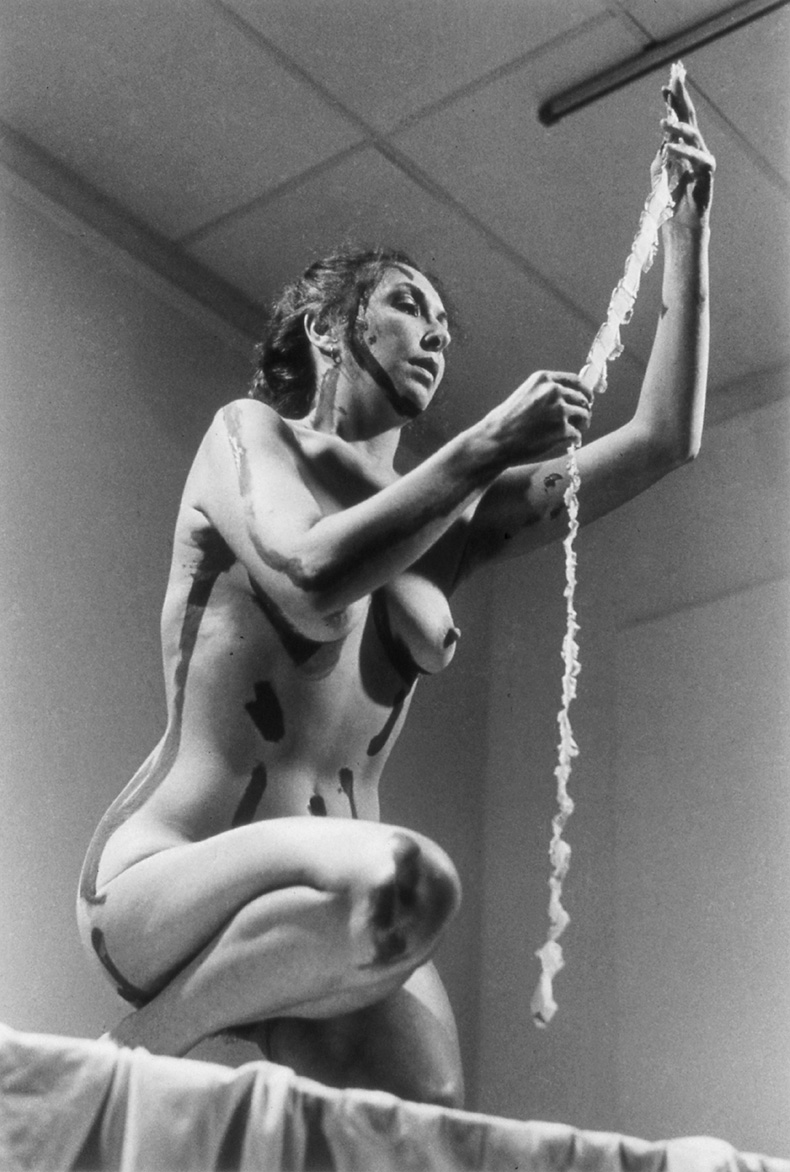On the upper floor of the Barbican Art Gallery, a group of semi-naked men and women are rolling around on the floor, clutching plucked chickens and handfuls of raw fish. Their movements are sometimes dance-like – as when the women, clad in hairy underwear, form a circle with their legs rippling upwards – and sometimes chaotic, even aggressive. At one point a woman is dragged around by her feet, holding a fish in each hand, while a man crouches, keening over a chicken cradled to his chest. Carolee Schneemann described Meat Joy (1964), her group performance – a recording of which forms one of the centrepieces of this survey exhibition – as an ‘erotic rite’, perhaps referring to the sacrificial imagery of animal carcasses and naked bodies, but also drawing attention to the contrarian nature of her art. Why can’t something be bodily and spiritual, grotesque and beautiful, comic and frightening, tender and violent?
Sir Henry Francis Taylor (1961), Carolee Schneemann. © Carolee Schneemann Foundation/ARS, New York/DACS, London 2022

When Schneemann began making art in the mid 1950s, painting portraits of her own naked body was enough to get her expelled from Bard College in New York (the school provided no life models). She dedicated her career to breaking down rigid stereotypes of femininity by celebrating emotion, chaos and mess. Her paintings, with which the exhibition begins, show early attempts to fuse emotion and intellect, expanding her gestures beyond the confines of the canvas. One Window Is Clear – Notes to Lou Andreas-Salome (1965) combines fluid brushstrokes of oil paint in vivid hues of blue and yellow with a collage of photographs of Rilke, Nietzsche and the Russian psychoanalyst to whom the work is addressed, as well as scrunched-up pieces of paper. From the bottom of the canvas, an unspooled cassette tape spills onto the ground, vaguely suggesting the appearance of bodily entrails. Recorded on the tape, though it remains unheard, is the voice of Schneemann reading Salomé’s writings on narcissism while on the back of the canvas (unseen in the exhibition) she has written her a letter.
This homage, though conceptually intriguing, is decidedly less effective and complex than the works in which Schneemann brings her own perspective to the fore. Fuses (1964–67), for instance, documents the artist’s sexual relationship with her then-partner, the composer James Tenney. The film was shot over the course of three years on a borrowed wind-up Bolex camera which could only record a maximum of 30 seconds of footage at a time and then cut, scratched, painted over, baked in the oven, dipped in acid and exposed to the elements, creating a feverish, stop-start collage wherein scenes of the couple making love are spliced with images of a snowy landscape and their cat, Kitch. In opposition to hyper-sexualised, male-orientated pornographic films, Fuses employs close and unflattering angles, alternately showing the sensuality, humour and violence of two bodies coming together. There are close-ups of pubic hair, a penis slumped against a leg, or rising, like some deep-sea creature, out of the shadows; Schneemann’s face shot upwards from the chin, appears almost cadaverous or otherwise gripped in a space somewhere between pleasure and pain, her eyes tightly scrunched. It is a portrait of real sex, but also of a life shared with another person.
Two film strips from Fuses (1964–67), Carolee Schneemann. Courtesy Electronic Arts Intermix (EAI), New York, the Carolee Schneemann Foundation and Galerie Lelong & Co., Hales Gallery, and P.P.O.W, New York; © Carolee Schneemann Foundation/ARS, New York/DACS, London 2022

Much of Schneemann’s art now only exists in recorded form – photographs, sketchbooks, grainy footage – a broad selection of which is presented in the lower gallery. Schneemann died in 2019; this is, inevitably, how we encounter most historical performance art, through objects and other people’s perspectives. While some of the archival materials on display possess an almost uncanny power, among them two crumpled strips of paper which Schneemann pulled from her vagina while simultaneously reading inscribed texts in her performances of Interior Scroll (1975), a lot here is easy to pass by. This has to do with the material – a piece of paper doesn’t scream out for attention in the same way as brightly coloured canvases or naked gyrating bodies – but also with the way in which the documentation is presented, for the most part, in glass vitrines.
Interior Scroll (20 August 1975), Carolee Schneemann, photographed by Anthony McCall. Courtesy the Carolee Schneemann Foundation and Galerie Lelong & Co., Hales Gallery, and P.P.O.W, New York; © Carolee Schneemann Foundation/ARS, New York/DACS, London 2022

It is important, of course, to preserve Schneemann’s work for future generations, to secure her place in art history (or ‘istory’, as she had it), but the idea of containing her art within a literal box, not to mention the loosely chronological themes around which the exhibition is arranged, feels at odds with the artist’s attempts to break away from linear narratives. Fortunately, the art, defiant in form, seems to provoke defiant acts. As I walked around the exhibition, the security alarm sounded repeatedly as viewers leant over the line to take a closer look.
‘Carolee Schneemann: Body Politics’ is at the Barbican Art Gallery, London, until 8 January 2023.



